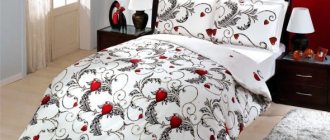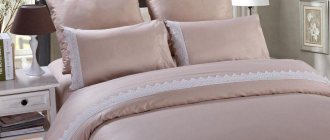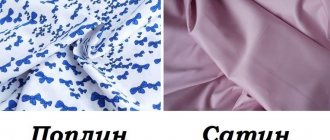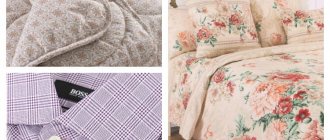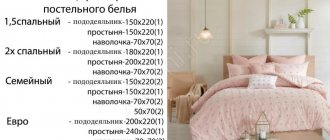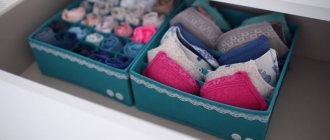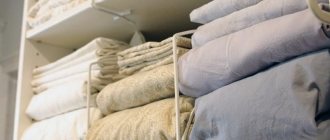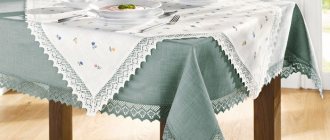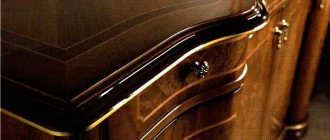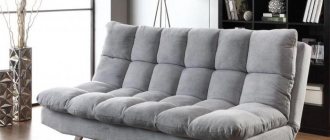Satin is a modern, stylish material with a durable plastic texture and original appearance. High level product. Textiles are readily used for decorating residential premises. We are happy to produce bed linen, curtains, tablecloths, bedspreads, home clothes and elegant items.
Satin is widely used in the production of bed linen.
Velvety soft fabric with a glossy effect and a wide range of colors will not leave even the most demanding consumer indifferent.
The elegance of silk and the practicality of cotton are harmoniously combined in satin. The price of satin is significantly lower than silk, but more expensive than other cotton fabrics. Durable fabric can withstand up to 300 washes.
Is satin cotton or synthetic?
This is a cotton fabric, smooth and silky on the front side and matte, dense on the back. This effect is achieved due to a special type of fabric manufacturing - satin weave.
Satin weave fabric
The process consists of a special interweaving of the main thread with a transverse (weft) thread. The warp thread is dense, and an elongated twisted weft thread is passed along the front surface. Alternate 4 main threads and one twisted front thread. And the more the thread is twisted, the stronger and more elegant the fabric is, with a rich shine and delicate smoothness.
It is obvious that thread obtained from ring spinning machines is preferable to thread obtained from rotary machines. Because the ring spinning machine produces a more twisted thread.
Sometimes mixed satin fabrics with the addition of elastane or polyester are found. The composition of the fabric is indicated on the label. But most often they use pure cotton fiber. It is most suitable for linen and clothing. This is a hygroscopic fabric, non-allergenic, pleasant to the body.
Cotton fiber
Main types of satin
It is not always easy to distinguish one type of satin from another, but it is worth understanding the existing variations in order to better understand the properties of a particular material:
- Satin stretch. As you can guess from the name, elastane is added to the composition to give the fabric stretch.
- Crepe satin. A combination of cotton with silk, viscose or synthetic crepe twisted threads.
- Mako-satin. Thick fabric of high quality thanks to carefully selected raw materials - long-staple Egyptian cotton.
- Silk. For the grainy, matte back, cotton threads are used, and for the shiny, satin front, silk threads are used.
- Satin jacquard. Double-sided, very dense fabric with embossed jacquard patterns obtained by alternating matte and shiny multi-colored threads.
- Satin velor. It is distinguished by the presence of a small pile on the front side.
- Stripe satin. A type of jacquard satin with characteristic stripes.
Receiving technology
To produce satin fabric, high-quality cotton is used. It is combed out, removing dirt and shorter, coarser fibers.
Satin production technology consists of the following stages:
- Threads are spun. For the front side of the fabric, twisted threads are used, and the more the thread is twisted, the higher quality and more refined the fabric. A ring spinning machine is preferable to a rotary spinning machine, as it twists the thread much more.
- Weaving cloth. For the production of satin, a 4:1 ratio of warp and weft threads is used, so the back side of the material is matte and soft, and the front side is smooth and shiny.
- Mercerization. The process consists of treating the fiber with a concentrated solution of caustic soda, followed by washing with water, first hot and then cool. As a result, cotton fiber changes its chemical structure, becomes stronger and smoother, and becomes colorfast.
Mercerization is a process that changes the chemical structure and improves the quality of the fiber.
The author of this idea and the developer of the process was John Mercer (Great Britain) 1845, after whom this unique technology is named. The fabric gained strength, but had greater shrinkage. In 1890, the technology was improved by Horace Lowe. During the production process, the author of the idea stretched the fabric and secured it, which prevented the fabric from shrinking in size. As a result, it received a silky shine without losing its strength.
The mercerization process is not cheap and significantly increases the cost of the fabric.
There is also an inexpensive type of satin manufacturing technology, which involves hot embossing of fabric - calendering. The surface is pressed in and becomes smooth, but the effectiveness is not long-lasting, the fabric loses its shine and color after the 10th wash cycle.
Calendering is the process of processing fabric on a calender, i.e. rolling fabric between hot rollers. This process turns round threads into flat ones, giving the fabric a silvery sheen - a “lacquer” effect.
Next, the fabric is bleached and dyed.
There are 2 methods of coloring:
- Pigment - the dye is applied to the front side of the fabric. The pigment does not penetrate deep into the fibers, remaining on the surface of the fabric. An inexpensive dyeing method, the color gradually deteriorates, and is relatively not resistant to fading and water treatment. Withstands up to 10 washing cycles well, then the colors fade.
Our expert's opinion
Irina Vladimirovna Kravchuk
Agronom.Guru website expert
Ask a Question
One of the advantages of the pigment printing method is its versatility; this method can dye fabrics from any materials, since dyeing does not require the affinity of the pigment to the fiber.
- Reactive Dyeing – Reactive dyes are used to securely bind the fiber to the color, making the color resistant to fading and washing. Withstands up to 300 washing cycles.
The reactive dyeing method is the most expensive, it binds the dyes to each individual thread, becoming their integral part, and the fabric never fades.
Satin weaving technology
Satin, calico and poplin are fabrics that are made by twisting two types of threads. Only satin weaving is more complex than representatives of the other two types. Cotton is used as the main material, but silk, synthetics and other fibers can be woven into the fabric. This will be reflected in the appearance and technical characteristics of the fabric. A dense thread is used for the warp. A thinner thread is twisted and woven into the warp, which adds shine to the front. The stronger the curl, the greater the shine.
The Great Silk Road
To improve the appearance of the fabric, additional treatments are possible:
- Marcerization. The fabric is treated with sodium hydroxide. The result is additional shine and strength. Colors become more durable.
- Calendering. Heated calender rolls are used. The fabric is rolled between them, smoothed out and becomes even more shiny and smooth. It is worth considering that this shine will decrease with each wash.
You might be interested in everything about satin: is it cotton or synthetic material
Weaving
Note! The back of the fabric is always matte. Only the front side shines.
Finally, the canvas is painted. Patterns and colors can be varied. Thanks to its characteristics, the material retains the brightness of color and pattern for up to 300 washes.
Color variety
When applying a printed pattern to a canvas, pre-dyed fibers are used. 3-D drawing is popular. This bedding looks very unusual and beautiful.
Bedding with 3-D pattern
How to choose satin bed linen?
High-quality textiles, made in compliance with all production technologies, cannot be cheap. It is sold only in specialized stores.
Street retail outlets sell cheap counterfeits, but prices can be unreasonably high. Let's not let ourselves be deceived!
When choosing satin bed linen, we take into account the following characteristics:
- High-quality linen will consist of 100% natural material. We check the product labeling by checking the label;
- the product should not have any odor. The sharp smell of the material indicates the use of low-quality dye;
- visual inspection of the material: stretch the sample, look at the light. The less light the fabric transmits, the higher the density;
- The fabric density must be at least 120 threads per 1 cm2. This indicator is indicated on the label. The higher the density of satin, the better quality it is, which means the bedding set will cost more. When making satin fabric, standard indicators from 80 to 200 threads per 1 cm2 are used;
- material with low density should cost less. In the production of such fabric, to increase strength, synthetic thread is used, which reduces the cost of the product. But this does not mean that the material is bad, it is also good in its own way. The choice is up to the consumer.
Regular satin has a density of 85–130 weaves per 1 cm2.
Description and composition
Paradise (by Alena Akhmadullina)
There are a large number of varieties of satin, and their composition sometimes varies quite a lot. But one common feature for all types is the predominant amount of cotton in the fabric base.
The type of satin and its cost may depend on both the quality and quantity of cotton threads used. And if inexpensive sateen uses synthetic materials along with cotton, then natural sateen is always 100% cotton.
Satin is distinguished from other fabrics by a special type of weaving, in which the base of the material consists of dense threads, and thinner and twisted threads are used for the front side. It is because the thread is twisted that satin gets its shine.
Usually, when weaving satin, four threads are taken for the warp per one thread for the front side.
The density of satin is quite high: depending on the type of satin, one square centimeter of material takes from 85 to 200 threads . Thanks to this, satin not only has increased wear resistance, but also perfectly retains its appearance even during long-term use.
For example, satin bed linen will begin to lose its shine only after three hundred washing cycles .
Advantages and disadvantages of satin bed linen
Satin fabrics have a luxurious, stylish appearance. Bed linen will give you comfort; sleeping under such material is simply bliss.
Textiles fit perfectly into the interior of the apartment, and look especially elegant in the interior of the bedroom.
The material has the following advantages:
Smoothness, silky shine. The pleasant appearance is due to the special texture of the fabric.
Durability, wear resistance. It will withstand repeated washings, will serve you for many years, maintaining its external chic. Practically does not shrink the fabric.
Brightness of colors. Holds color perfectly, does not fade or fade.
Breathability. The material provides good ventilation. Free air exchange allows the skin to breathe, providing comfort.
Thermoregulation. The material has low thermal conductivity: it will keep you warm in the cold and cool in the heat.
Hypoallergenic. It has no contraindications for people with allergic reactions. Therefore, it is used with pleasure for children.
Hygroscopicity. Absorbs moisture and sweat well. This property of linen has a positive effect on comfortable rest and sound sleep.
The fabric drapes well and is laid in beautiful ruffles. This quality is used when sewing elegant clothes and for interior textile decoration.
The disadvantages of satin include:
Expensive. A quality product is not cheap.
The material "slips". This quality of satin used in bed linen is not perceived positively by everyone. Having cotton pajamas will soften negative feelings.
Difficulties in cutting and sewing due to the sliding effect of the fabric. It is especially difficult to work with the edge of the product.
Classification by nature of threads
The satin weave method can be used to weave fabrics from raw materials of various natures.
- Satin made only from natural cotton.
- Fabric made from cotton and polymer fibers. The cost of such fabric is slightly less than all-cotton fabric, and the wear resistance is higher.
- Satin double made from cotton and viscose. Used for sewing linings.
- Satin satin is sometimes called silk satin and is made from silk and cotton threads. Used for sewing elegant clothes, tablecloths, curtains.
- Crepe satin is made by combining cotton threads with natural and artificial silk. Satin and satin are different. This fabric is positioned as crepe satin, 100% polyethylene and no cotton, so check the composition!
Natural or synthetic satin
All satin fabrics can be pure cotton or blended. The composition allows for minor additions of synthetics; the percentage of the additive must be indicated on the product labeling. The mixed materials used are polyester, lycra, elastane, rayon, viscose.
Unscrupulous manufacturers often neglect the norms, adding more synthetics to the material than normal. For example, cheaper polyester.
How to distinguish natural satin from synthetic?
➡️ To determine whether the fabric is natural or synthetic, it is enough to carry out some manipulations:
- Rub some of the fabric. Natural material will not be electrified.
- Pull the thread from the edge and set it on fire. Synthetic melts, emitting black smoke. Natural thread burns quickly, without odor or smoke.
- Determine the weight of the material. Natural will be much heavier than artificial.
- The price of the product. Natural goods cannot be cheap. High-quality goods are sold in stores with a good reputation. Counterfeits can be found most often in the market or street retail outlets.
Remember the fabric - natural fabric does not leave creases. In the photo: natural satin
How it is produced
Satin manufacturing technology includes not only weaving fabric. One of the important points in creating the material is the processing of cotton threads. Cotton fibers undergo a mercerization procedure, which consists of special treatment with alkali and acid. During processing, the threads swell and small fibers adhere or are removed, resulting in the fibers becoming as smooth as possible. This process requires large material costs and time, so satin produced in this way is more expensive than other types.
To reduce the cost of material, manufacturers often use embossing technology. In this type of processing, the silkiness of the fabric is achieved by pressing the entire fabric, rather than individual fibers. After such treatment, the silkiness of the material is lost faster.
In addition, to achieve a silky effect, the weft thread used to weave the fabric is tightly twisted. In this case, up to 4 warp threads can be woven with one weft thread. During the weaving process, the weft thread ends up on the front side, creating a glossy surface, and the warp threads on the back side, which has virtually no shine.
Children's bedding made of satin
Children's satin bed linen compares favorably with linen made from other materials. High-quality satin is ideal for children's skin. The ability of satin to absorb moisture that forms on the body during sleep will make your sleep comfortable and restful.
The material is hypoallergenic and environmentally friendly, retains heat well and breathes.
Satin sets for children make them bright and beautiful. Many factories specially print children's drawings, cute umbrellas, mushrooms, and cars. With all this, smoothness and comfort will provide the child with sweet dreams.
The colors on the fabric last a long time, are resistant to fading, and do not fade during washing. The material is durable, soft, elastic.
Price scale
The fabric is produced by large factories in Russia, Turkey, China, and Italy. Russian manufacturers offer mixed fabric costing from 180 rubles per meter. Cotton material costs from 250 rubles per meter. Luxury varieties start from 1000 rubles per meter. The cost is influenced by the composition, the presence of a pattern or embroidery.
Chinese satin is considered elite, its price tag starts from 1,500 rubles per meter. Turkish manufacturers also have good quality.
A ready-made set of satin lingerie costs 3–4 thousand rubles. Jacquard and embroidery are more expensive - from 5 thousand rubles.
The material is purchased in specialized sewing stores and ordered via the Internet.
Which is better: calico or satin? Which bedding is best?
Calico is also used to sew bedding sets. Calico is as popular as satin, although it is inferior in quality.
- It is less dense, so it wears out faster and retains its properties for up to 120 washing cycles.
- It does not have a structural shine like satin, so it is inferior in appearance. This is due to the fact that these fabrics differ in different ways of weaving threads during production.
- When washed, it shrinks high, up to 7%.
The plain weave of calico makes it less dense and less flexible.
? Nevertheless, bed linen made from calico is in demand among the population. The question is the price.
Calico sets are cheaper than satin ones, and this is also an important indicator in making a decision - calico or satin.
Advantages of satin material
A number of positive characteristics can be identified:
- A special technique of weaving threads when creating fabric gives the fabric durability and wear resistance. Satin is not afraid of numerous washes and frequent wear. The fabric practically does not wrinkle and is dense enough to serve for many years and maintain its original beautiful appearance.
- Lightweight and skin-friendly material is perfect for sewing clothes for children.
- Natural satin is hypoallergenic. It does not cause allergic reactions due to the presence of predominantly natural components in its composition.
- Despite the high level of density, cotton products can easily pass air flow. The clothes are ideal as a summer option for men, women and children. In winter it will maintain a warm body temperature, and in summer it will become a cool, airy garment.
- Lingerie made of satin fabric looks chic and festive. Unlike silk, from which the material is practically no different in appearance, the canvas retains temperature and is comfortable for sleeping.
You might be interested in this Description of cotton fabric: types and properties of cotton materials
Summer clothing option
In addition to the advantages of the fabric, it is worth mentioning its hidden disadvantages. The disadvantages include slipping, which is inherent in the fabric.
Production of satin products
The main purpose of the fabric is the production of bed linen. The material, due to its quality, ensures a comfortable, healthy sleep.
Satin has also found application in home textiles; curtains, bedspreads, and tablecloths are made from it. The ability of fabric to retain its shape and bright colors are used to create home comfort. Textiles make you happy for a long time and lift your spirits.
Clothes are made from satin: men's shirts, women's dresses.
An inexpensive type of satin is used as a lining material for the main type of clothing.
A new direction for satin: using it for stretch ceilings. Interesting fabric material will decorate favorably and make any interior original.
The calm matte shade, in contrast to the mirror surface of glossy ceilings, will advantageously decorate any interior.
Caring for stretch satin ceilings involves wiping off dust with a dry cloth. To remove stains, use a solution with 10% ammonia.
What standards are used in production? What do they take into account?
Bed linen is often made from satin. State standards determine the values of such a fabric parameter for linen as density. GOST 31307-2005 indicates that this indicator for satin weaving is 110–220, 220–250 and over 250 g/m2.
From GOST 21790-93 we learn about the standards for breaking load and abrasion resistance of finished fabrics.
| Fabric name | Breaking load of a fabric strip measuring 50 × 200 mm, N (kgf), not less | Resistance to abrasion along the plane, cycles, not less | |
| based on | one duck at a time | ||
| Satin weave with surface density, g/m: | |||
| up to 220 incl. | 353 (36) | 618 (63) | 2000 |
| St. 220 – 250 | 392 (40) | 736 (75) | 2500 |
| 250 | 441 (45) | 834 (85) | 3500 |
Satin dress
The most popular fashionable style of satin dress is considered to be a sheath dress. This style is feminine and the fabric gives a chic, sophisticated chic, complimenting the woman.
Satin sheath dress by Karen Millen
For special occasions, a bustier dress or other form-fitting style made of bright satin will make the owner of the outfit the queen of the ball.
You won't find a better fabric for a wedding dress. The elegance, restraint, and sophistication of satin are emphasized by lace, sewing with beads and rhinestones. Divine white satin for the most special moments.
White satin wedding dress
Often, inserts made of satin material are used to sew evening dresses. This technique creates a unique image, makes the dress elegant and spectacular.
Designers love to use satin to create their fashion collections. A versatile material, well suited for both dinner in a restaurant and business meetings.
Summer light dresses made of satin are good for both young girls and ladies of any age and texture. Flowing, breathable satin will successfully hide figure imperfections and make you feel comfortable in any weather.
Summer light satin dresses
Identifying a fake
To buy a really high-quality satin set, use the following recommendations:
- Try to buy underwear only from trusted sellers, avoid street kiosks and markets where counterfeits are most likely present.
- Read the label. A good material will be 100% cotton, and information about the mercerization of the threads will be an undoubted indication of quality.
- Trust your tactile sensations. The more pleasant and smooth the material is to the touch, the longer it will retain its silkiness.
- Hold the linen in your hands, the heavier it is, the more natural it is.
- Fold the material, real satin will have no creases.
- Check the density of the fabric in the light. The outlines of objects should not be visible through a high-quality canvas.
If you don’t trust your observations, ask friends for recommendations or study information about the bed linen manufacturer on the Internet.
Classification of bedding material
Satin is divided into classes according to purpose, composition, and method of dyeing.
According to the method of applying the pattern, satin can be:
- Plain. The absence of a picture makes the kit cheaper. Used for budget sleeping sets, for combined sewing.
- Printed. The design is applied to the finished fabric. The patterns on the material are very diverse: from ordinary floral patterns to complex abstract compositions. The design is applied to the fabric using one of the following methods: reactive or pigment. The density of printed satin is 85-170 threads per 1 cm2.
- 3D printed. Modern technology of applying a pattern with a volume effect to the finished fabric. The fabric selected is dense, with a rigid structure, the number of threads in the weave is above 220 per 1 cm2.
Printed satin
Solid satin
3D printed satin
Classification by origin of fabric fibers:
- Mako satin, "cotton silk". An ideal natural luxury fabric, the most expensive, but definitely worth it. They are made only from the highest quality Egyptian cotton, which is distinguished by its especially long silky fibers. The density is high, at least 220 threads per 1 cm2.
- Satin-satin. The magic of silk. This material reflects the best properties of both satin and satin. The smoothness and softness of the front satin surface and the strength of the cotton back. The material slips less than plain satin. The strength of the fabric is due to the special satin weaving of the threads. Elegant clothes, elegant curtains, tablecloths, and bedspreads are made from satin-satin. To reduce the cost of the material, satin-satin can be produced entirely from synthetics.
- Crepe satin. Double-sided material that can be combined. The front satin and matte back sides of the fabric look equally great. In the production of fabric, a special type of weaving is used, called crepe twist: alternate threads twisted on the right or left sides. It is similar in appearance to satin, but has a different composition. It is acceptable to use polyester or artificial silk in the manufacture of fabric.
Bed linen “Magic of Silk” Mako satin
Crepe satin fabric
Silk satin
The crepe-satin material looks great in a home interior, drapes easily, does not slip, does not wrinkle, does not fade. Wedding and evening dresses are made from it, and handbags and shoes are covered with fabric.
There are also disadvantages: the fabric frays a lot when cutting and does not allow air to pass through well if it contains synthetics.
- Novosatin. Thin fabric containing synthetic material. The material is inexpensive and is mainly used in decorating home textiles.
Novosatin
- Milatex. Collection of Milatex satin bed linen with bright original colors. The material looks rich and stylish.
Satin bed linen Milatex
- Silk satin. The most common and famous type of premium satin. The front side of the fabric is woven from silk, and the back side from cotton. Mandatory procedure for mercerization of fabric in the production of silk-satin. The use of artificial silk is allowed. It is in demand when sewing evening and formal dresses, expensive home textiles.
Satin silk bedding
- Satin jacquard and stripe satin. Both of these materials belong to the elite group. It contains only 100% high quality cotton. The canvas does not have a reverse side. The pattern is double-sided, resulting in it being voluminous and embossed. A pattern is obtained on the canvas during the weaving process by interweaving threads. Using threads of different colors, you get original designs on the canvas that will delight you for many years. The mercerization process provides additional strength and gloss to the fabric. Luxurious textiles retain their quality properties for many years. Density from 170 to 220 threads per 1 cm2.
Bed linen satin jacquard
- Printed satin. Fabric, the design on which is applied during the manufacturing process using a new high-tech method. The quality of printing creates a stable design that does not fade or wear out for a long time. The most colorful and varied textiles in color. Designers offer a huge selection of patterns and prints, just a riot of floral motifs. The palette of colors is not limited: bright rich motifs or calm pastel colors, a riot of colors or cold geometric patterns. A choice of colors to suit every taste.
Children are special connoisseurs of printed textiles: cartoon and fairy-tale characters, cute funny animals and toys. Children's bedding, bumpers for cribs and strollers, blankets, and pillows will entertain your baby with colorful designs.
- Mansi-satin. Universal textile, a combination of two materials: satin on one side and fleece on the other. Satin contains 100% cotton fiber, fleece contains 100% polyester. The product made from mensi-satin is light, soft, washes well and dries quickly. Does not wrinkle, so does not require ironing. Hypoallergenic and antibacterial, as bacteria and dust mites do not live in fleece. Flammable fabric due to polyester content. Can be used as a blanket. The textile is soft, warm, and wicks moisture away from the body well.
The affordable price of Mansi satin makes it accessible to a wide range of consumers.
- Mixed. A synthetic thread is added, most often polyester. Used to reduce costs, increase the strength and wear resistance of the material.
- Satin double. Combination of cotton and viscose. Viscose silk as the base material and staple or cotton cross thread. Used as lining material when sewing coats or dresses.
- Gloss-satin (poplex) with spraying. The fabric is made from very thin threads, only a few microns thick. Thanks to this, the material is delicate, airy and soft. Gloss-satin is breathable and hygroscopic. Retains heat well and removes moisture from the body during sleep. Blankets, pillows, covers for bed linen and furniture are made from this fabric.
- Twill-satin. Budget option for satin. Not everyone can afford premium-class satin, but they want to sleep on something smooth and pleasant. Twill-satin is at your service. The fabric is less dense, but not loose. The dye is not reactive, but pigment, that is, the dye is less fixed than on more expensive fabrics. Accordingly, you just need to take into account the washing mode and choose a fabric that is less bright, more pastel colors. But overall the fabric is excellent, I have no complaints about it. A distinctive characteristic is the interweaving of cotton and satin threads symmetrically in a ratio of 2:2. The fabric is used for sewing home textiles.
Bed linen twill satin
Gloss satin pillow
Classification of satin by use and purpose:
- Staple. Thin, light, clothes, dresses, sundresses are sewn from it. This type of fabric is created from long cotton fibers. That is why the width of the fabric is no more than half a meter. The fabric contains lavsan in a 1:1 ratio with satin
- Corset. Characterized by dense weaving of threads, the fabric is used for formal wear and wedding dresses.
- Curtain. Decorative canvas for interior decoration.
The dress type is mainly suitable for the production of clothing and bedding sets.
Cost of fabrics
How much does satin cost? The price of a material is calculated based on a variety of factors, not all of which relate to quality characteristics.
- Manufacturer - satin is produced in huge quantities and by many enterprises; it is almost impossible to single out well-known brands from the masses. The cost is influenced not so much by the manufacturer as by its placement. The cost of imported fabric will be higher in any case, since it includes not only production, but also transportation and customs clearance.
- Variety - the price of the product depends on the density and characteristics of the weaving. The cost of regular or printed satin is 85 rubles and above, two-color jacquard - from 197 rubles. Crepe-satin and satin are even more expensive - from 280–300 rubles. per meter
- Pattern – a popular or fashionable pattern can significantly increase the price. This trend is clearly visible in bed linen: the cost of a set with fashionable cartoon cars is higher than with a traditional floral pattern.
Caring for satin fabric
Satin is highly durable and unpretentious, can withstand up to 200-300 washing cycles as a standard and does not require any special care.
It is enough just to follow the rules recommended for the care of satin products:
- Before washing, turn the linen inside out, with the stockinette stitch facing inward.
- Wash with a mild detergent without aggressive bleaching additives or chlorine preparations. The material tolerates washing well even at 950, but this temperature should be used as rarely as possible. The optimal temperature for washing clothes is 30-400.
- Satin linen should be washed separately with other items (towels, pajamas, etc.)
- Use conditioner. Conditioning will make the fabric softer and more pleasant, and will retain color better.
- Dry in a place protected from the sun, well straightened, so that there are no creases in the fabric. For the same reason, do not dry on heating radiators.
Iron from the reverse side slightly damp; do not set the iron to maximum heat.
Satin is a low-wrinkle material, so you can do without ironing. ✅ By following these simple rules, we extend the quality characteristics of the material. The linen will remain like new for a long time and delight you with its attractive appearance. Once you try high-quality lingerie, you will no longer be able to deny yourself the pleasure. It’s nice to feel like a reigning person in the morning, getting out of bed covered with satin linen - a queen or king. Therefore, we are pleased to offer you the choice of excellent satin materials.
Story
Plain Satin
In the 12th century in China, satin was used as a material for sewing expensive and colorful ceremonial robes.
Such clothes were unaffordable for ordinary residents of the country, but in wealthy Europe, fashionable members of the aristocracy could afford outfits made from this fabric.
For the first time, satin began to be exported from China at the end of the 12th century, but until 1850, no one in Europe was engaged in the independent production of such material.
Only in the mid-nineteenth century was the production of satin in Europe patented, and for a long time the fabric was used exclusively for sewing expensive dresses for celebrations and for creating equally expensive exclusive lingerie.
But already in the 20th century, when satin production technologies were improved, not only representatives of the aristocracy and clergy, but also ordinary citizens could afford satin products. Satin clothes are no longer a sign of rich people.
